R S Japan Porcelain Blue With Pink Roses Tea Set
Fakes, Copies and Reproductions of R.S. Prussia, Germany, Suhl, Poland
For almost 100 years, 1869 to 1956, Reinhold Schlegelmilch's initials, RS, appeared in various marks on fine German porcelain. Probably today's most desired pieces are those marked RS Prussia. Rare blanks with rare decorations, such as animals or portraits, of RS Prussia can bring $3,000-$8,000. More common floral pieces have routinely sold for $75-$350. Other sought after marks include RS Germany, RS Suhl, and RS Poland.
Due to it's higher value, the RS Prussia mark has been forged and copied since the late 1960s . New RS Suhl appeared in the early 1990s, and now, in 1998, RS Germany and RS Poland are being reproduced. This article will review the new and forged RS marks and compare them to original markings. It will also look at other ways fakers attempt to enhance or imitate RS porcelain.
Background on Schlegelmilch Porcelain
Between 1861 and 1882 there were three porcelain factories started in the city of Suhl (in what is today Germany, then Prussia) by persons with the last name Schlegelmilch. Erdmann S. in 1861; Reinhold S. in 1869 and Carl S. in 1882. Until recently, it was thought all the Schlegelmilchs were family related. Research by R.H. Capers and Mary Frank Gaston in 1992-94 has shown: 1) none of the factory owners were brothers, and, 2) they did not have a common father, Rudolph Schlegelmilch, supposedly commemorated in the RS mark. Most of the new information came from a previously unpublished German research paper on the Suhl porcelain factories by Bernd Hartwich written in 1984. Gaston presents a revised review of marks and dates used by all the Schlegelmilch factories in her books, Collectors Encyclopedia of R.S. Prussia 3rd Series and 4th Series published by Collector Books. For this article, however, we are focusing only on the RS marks shown in Fig. 4 below.
Although some one-of-a-kind presentation pieces and heavier hotel ware were made by all Schlegelmilch factories, the vast majority of production was lightweight high quality porcelain for use on middle class tables. The primary market for this porcelain was in the swelling population of late 19th and early 20th century America where most of the RS porcelain was sold. The Suhl factories fortunes rose and fell with the American economy, trade tariffs and tastes.
The vast majority of original decorations– whether portraits, flowers, landscapes, animals, birds– were transfers (decals). Handwork, if used, was primarily to blend the edges of the transfer images into the background and apply gold or enamel trim. All transfer decorations are over the glaze. Distinctive blanks featured molded designs of flowers, fruits, icicles and geometric shapes. Values of authentic pieces are based on a combination of blank, decoration and mark.
Most original marks were applied fairly late in the production process. They are protected by only a light glazing and are subject to wear. The basic authentic RS marks, the so-called wreath marks, and when they were used are shown in Fig. 4 below.
Keep in mind there are many other authentic marks. These four are featured because they are the ones being copied and forged. Many authentic marks include additional words and symbols. For a complete listing, refer to the Gaston series.
Fake and Forged Marks
Not all original RS porcelain is marked and there are tremendous price differences between marked and unmarked examples. A marked piece will bring five to ten times the amount of an unmarked piece. Even when a piece is a known RS blank with a known RS decoration, if it is unmarked it brings far less. This wide price difference has lead to the widespread forging, copying and reproduction of marks.
There are several categories of new marks. There are: 1) new marks on old but unmarked genuine RS pieces; 2) new marks on old porcelain from other manufacturers; 3) new marks on various kinds of new porcelain; and, 4) mass produced reproductions with close copies of old marks applied at the reproduction factory. The first three groups are generally small scale do-it-yourself home projects or hired out to china studios or "restoration" artists. By far the largest source of new items are reproduction wholesalers who import thousands of pieces with confusing marks that resemble originals.
Individually applied fake and forged marks have been around since the late 1960s. Mass produced reproductions with RS marks followed in the early 1970s. Twelve marks dating from 1960 to the present are shown in this article. These new marks are shown as broad examples of the wide variety of new marks you may encounter. Rather than try and memorize all the new marks, concentrate on learning the basic features of the authentic marks. Once you understand the key elements of an original, you should be able to catch most fakes and forgeries.
New marks applied to reproductions in overseas factories usually appear technically similar to old marks because both old and new were applied at the time of manufacture. The major exception seems to be the new hatpin holder shape shown in Fig. 7-b. There is never any glazing on the bottom of this particular shape. The mark is applied to a biscuit finish surface.
New marks individually applied by do-it-yourself forgers to existing porcelain frequently leave tell tale clues. The surface surrounding these marks is often higher than the mark. This is caused by adding material or glazing to cover undesired marks or blend in the new mark. It's a good idea to run a fingernail across any suspect mark to check the surface for differences. Another good test is to use a long wave black light which can catch many attempts at reglazing the bottom to seal in a new mark.
Confusing Molds and Blanks
Authentic molds and blanks are well documented in the Gaston books and for years have been used to identify unmarked genuine pieces. Unfortunately, original molds and shapes are also being directly copied by reproduction importers. Buyers now face not only new marks that look old but shapes that look old as well. The new muffineer reproduction in Fig. 5, for example, is virtually identical to the original shape in Fig. 6. A confusing red/green wreath mark also appears on the bottom of the reproduction. Shape or mold alone any more is not necessarily a guarantee of age or authenticity.
Porcelain Quality
Original RS porcelain is thin, lightweight and translucent. Translucent means that light will pass through it. A simple test is to hold an object up to a bright light or window. Now place your open fingers behind the object. Your fingers should cast a dark shadow through the object. Keep in mind, however, this test is not a guarantee of age but only a quick test of whether an item is true porcelain. If you find an RS Prussia mark on an item that is not translucent, be very alert and inspect the item thoroughly. Remember that forged marks can be put on almost any piece, new or old.
Many of the reproductions, particularly those made in Japan, are quite good quality porcelain. In addition to being translucent, original RS porcelain is smooth and glassy to the touch in undecorated areas. A number of the cruder reproductions made of clay and not porcelain have unglazed bottoms. Insides of some new pitchers and vases are also unglazed.
Other Enhancements
Sometimes fakers will remove less desirable and less valuable decorations from genuine RS pieces and add decorations more in demand. Original decorations can be removed by sanding or hidden under a layer of new paint. Then the more expensive transfer–such as an animal or portrait– is added. Of course you could also encounter a piece where both a new mark as well as a new decoration has been applied.
Many decorations that bring big money on original RS pieces were originally paintings by famous masters. These scenes are still available through catalogs of transfers sold to present day china painters. These include the so-called Melon Eater series by 17th century Spanish artist Murillo, classical scenes by various 18th century artists named Kaufman and portraits by Francois Boucher. New transfers often have the artists' "signatures" and "dates". Other popular transfers still available include a variety of game birds, landscapes, animals and Gibson-girl type portraits.
One of the best ways to catch recently applied transfers is to hold the object to the light with the decoration facing you. Look for traces of the original transfer which may appear as dim outlines or shadows behind the new transfer. Also look for the dot pattern of modern color printing. Old color transfers were generally lithographed. Lithographed colors should generally appear as solid patches or clumps of irregular dots. Black light can also be helpful to detect new paint over original transfers and borders where new transfers meet the original surface.
Summary
When evaluating a piece, be sure to examine and study a variety of features. Is it the correct mark on the correct blank with the correct decoration? New blanks are made in old shapes. Old appearing marks appear on mass produced reproductions. New transfers can be applied to genuinely old pieces.
When buying an expensive piece of RS, it is a good idea that mark, decoration and blank all be described by name on a written receipt that includes an approximate year of production.
Mary Frank Gaston's books Collectors Encyclopedia of RS Prussia 1-4, are the standard references on the subject. Her series is published by Collector Books, PO Box 3009, Paducah, KY 42002-3009. Credit card orders call (800) 626-5420.
Another useful book on RS Prussia is Collecting RS Prussia by George Terrell, Jr., © 1982, Books Americana. It has about 1000 pieces photographed plus a separate chapter on fake blanks, molds and switching transfers. It's out of print, so try a used book dealer.
Handbook of Erdmann and Reinhold Schlegelmilch Prussia-Germany and Oscar Schlegelmilch Germany by Clifford Schlegelmilch (3rd edition, 1973) is interesting for its original catalog pages of Schlegelmilch porcelain. Most of the text has been made obsolete by the recent research of Gaston, Capers and Hartwich. Shelves of examples in color photos.
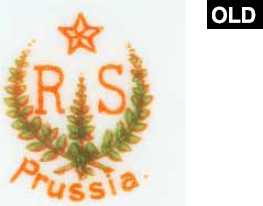
Genuine RS Prussia marks have red letters, a red star and red outlines to the wreath.
Leaves in the wreath usually appear green. Red areas can look rusty brown; sometimes entire mark may be green.
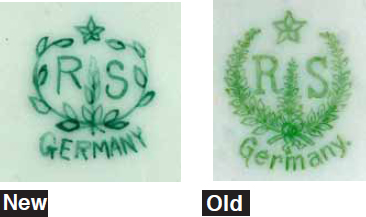
The new RS Germany mark currently on reproduction imports is the crude handpainted mark shown above left. It appears in bluegreen paint. Original marks are green or blue .
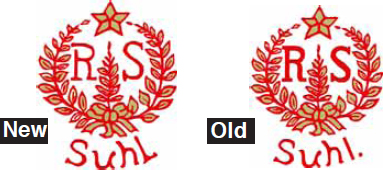
In the new mark, the letter `L' is uppercase with no period after after it. The old Suhl has a lower case "l" and a period at the end. The letters, star and outer edges of the wreath are red; the inside of the wreath is green.
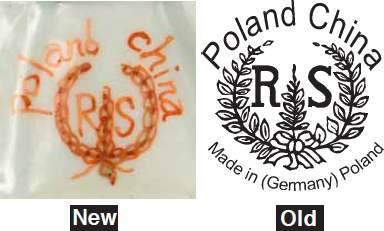
New mark is handpainted in orange/red paint. Original mark is a transfer with the words "Made in (Germany) Poland" around the bottom. All lettering is red. This is the most recent of all the genuine RS marks. It was used after WWII, ca. 1948-1956.

Fig. 1 All of these marks are fake marks on reproductions. New marks first appeared during the 1960s.
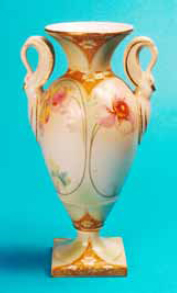
Fig. 2 New swan-handled 10" vase, marked R.S. Suhl, from reproduction importer. Poppy flower decoration on good quality porcelain.
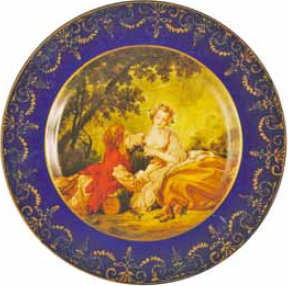
Fig. 3 New 8-inch plate with new RS Prussia mark
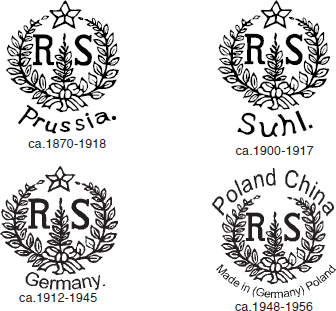
Fig. 4 Approximate dates the various authentic RS wreath marks were used on Schlegelmilch porcelain.
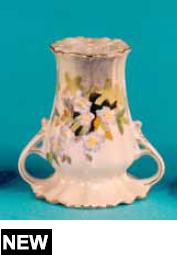
Fig. 5 Reproduction muffineer copied from old shape. New red/green RS wreath mark.
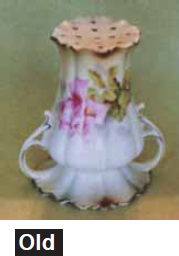
Fig. 6 Original muffineer, mold #781 served as model for the reproduction.
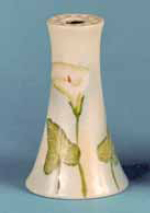
Fig. 7a
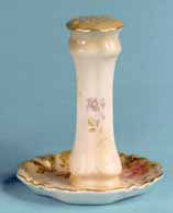
Fig. 7b
New hatpin holders: Fig. 7a, 5", new R.S. Germany mark; Fig. 7b, 4½", new R.S. wreath mark. The shape in Fig. 7b is used for a wide range of reproductions including Nippon, Flo Blue, etc.

Fig. 8 Close up of modern transfer with Boucher signature, dated 1759. This signature appears on a number of new pieces with new RS Prussia marks.
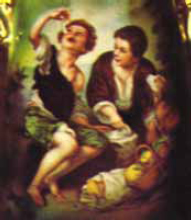
Fig. 9 Scene from Melon Eaters series. Various vintage scenes like this were still available as new transfers sold in china decorating shops.
New, Fake & Forged R.S. Prussia Marks
Check list for R.S. Prussia Marks
| Use this chart to help identify typical new, fake, and forged R.S. Prussia marks. As you can see from the photos above, most new marks show several of the common problems shown in the chart. But remember, marks are only one clue to authenticity. Also compare decoration and blank shape (mold). | |
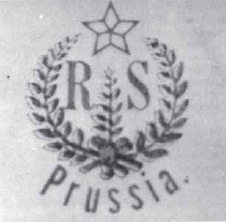
PR-1 Red and green decal. Sold in sheets of 140 in late 1960s. Produced in America.
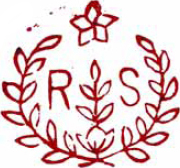
PR-2 Red or green/ blue ink stamp. "Prussia" not included. Since early 1980s on reproduction imports.
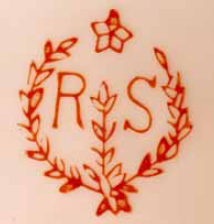
PR-3 Red ink stamp."Prussia" not included. From ca. 1980 on reproduction imports.
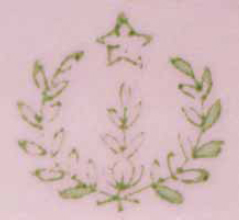
PR-4 Poorly formed transfer in green only. Does not include "Prussia." Ca. early 1980s on reproduction imports.
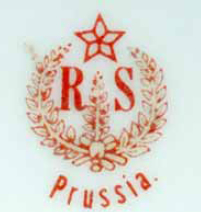
PR-5 Red and green transfer. From mid to late 1980s on reproduction imports.
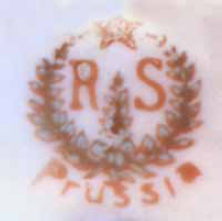
PR-6 Red and green transfer. Since early 1980s on reproduction imports.
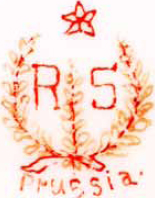
PR-7 Red and green hand painted forgery, ca. early 1990s on genuinely old but unmarked pieces.
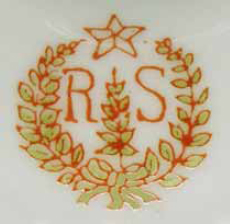
PR-8 Red and green transfer. "Prussia" not included. Ca. 1990 to present on reproduction imports.
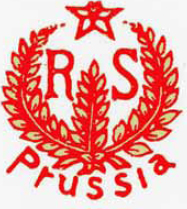
PR-9 Red and green transfer used ca. 1998 on reproduction imports.
melendeznitandeaughs.blogspot.com
Source: https://www.realorrepro.com/article/R.S.-PrussiaGermanySuhlPoland
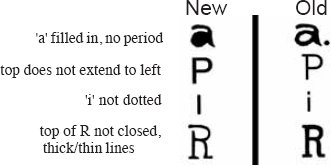
0 Response to "R S Japan Porcelain Blue With Pink Roses Tea Set"
Post a Comment